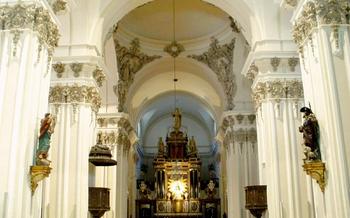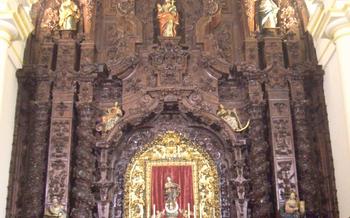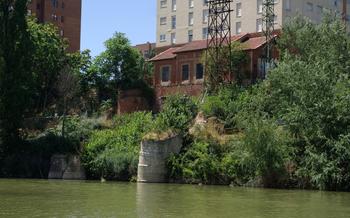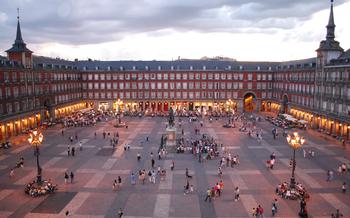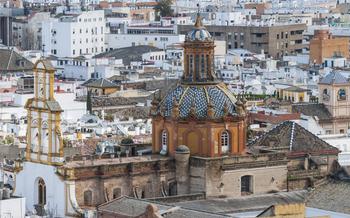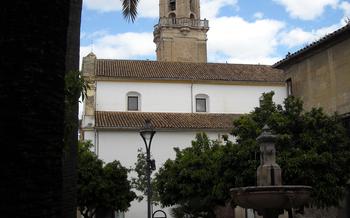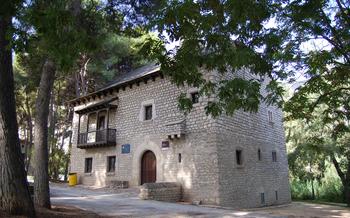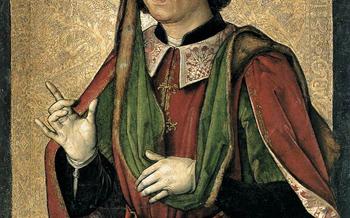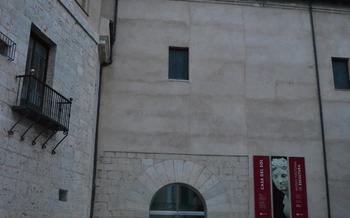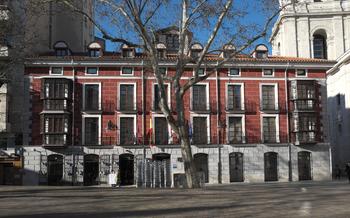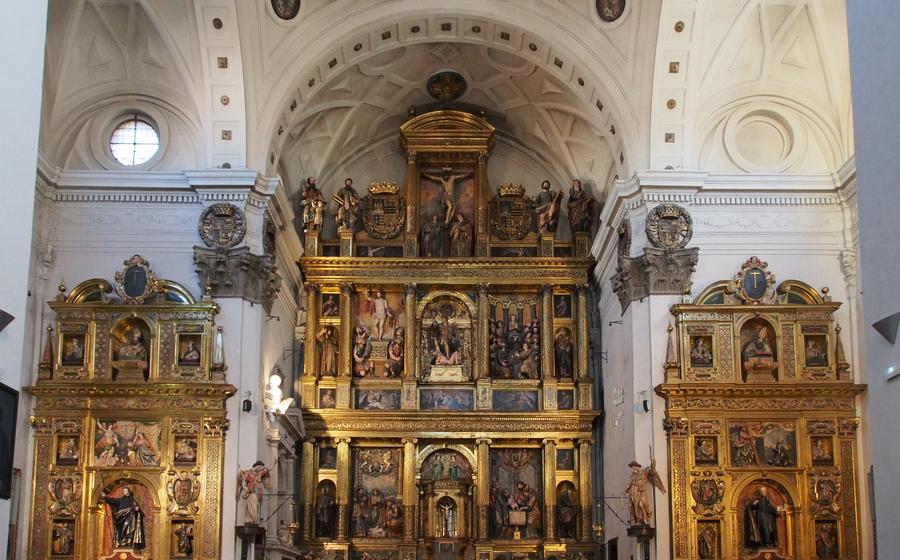
Iglesia de San Miguel y San Julián
- Step Back in Time: Exploring the Romanesque Origins
- Marvel at the Gothic Masterpieces
- Admire the Renaissance and Baroque Touches
- Exploring the Chapel of San Julián
- Practical Tips for Visitors
- Guided Tours and Audio Guides
- Accessibility for Visitors with Disabilities
- Nearby Attractions and Points of Interest
- Insider Tip: Discovering Hidden Details
Step Back in Time: Exploring the Romanesque Origins
The Church of San Miguel y San Julián stands as a testament to Valladolid's rich history, with its roots firmly planted in the Romanesque period. Constructed in the 12th century, the church initially served as a small Romanesque chapel, reflecting the architectural style prevalent in the region during that era. Distinctive features of this early phase include the sturdy construction with thick walls, rounded arches, and a simple, yet elegant, design.
As Valladolid grew in prominence and significance, so too did the church, undergoing several expansions and modifications. During this time, the Romanesque style gradually blended with emerging Gothic influences, resulting in a captivating fusion of architectural elements. The exterior of the church showcases a harmonious interplay of Romanesque simplicity and Gothic grandeur, with pointed arches and ribbed vaults adding a sense of verticality and lightness to the structure.
The church's transition from Romanesque to Gothic represents a fascinating chapter in its history, reflecting the evolving artistic and architectural trends of the time. This blend of styles creates a unique and visually appealing aesthetic that sets the Church of San Miguel y San Julián apart from other religious structures in the region.
Marvel at the Gothic Masterpieces
The transition to Gothic architecture brought a new era of splendor to the Church of San Miguel y San Julián. The ribbed vaults, supported by slender columns, create a sense of soaring height and ethereal lightness. The pointed arches, a defining feature of Gothic architecture, add a dynamic and graceful touch to the interior. Intricate ornamentation adorns the walls, columns, and capitals, showcasing the exceptional craftsmanship of the Gothic period.
Among the notable Gothic artworks, the altarpiece in the main chapel stands out as a masterpiece. Carved from alabaster, it depicts scenes from the life of Christ and the Virgin Mary with exquisite detail and realism. The expressive faces and intricate drapery of the figures bring the biblical narratives to life. Other Gothic sculptures, such as the life-size statue of the Virgin Mary, showcase the artistry and devotion of the period.
The blend of Gothic and Romanesque elements in the Church of San Miguel y San Julián creates a harmonious and visually captivating space. The church stands as a testament to the architectural prowess and artistic sensibilities of the medieval era, inviting visitors to immerse themselves in the beauty and grandeur of Gothic masterpieces.
Admire the Renaissance and Baroque Touches
During the Renaissance and Baroque periods, the Church of San Miguel y San Julián underwent significant transformations, incorporating elements from these artistic movements into its existing structure. The harmonious blend of Gothic, Renaissance, and Baroque elements creates a unique and captivating aesthetic.
One of the notable Renaissance features is the intricate altarpiece in the main chapel, which showcases a combination of painting and sculpture. The altarpiece depicts scenes from the life of Jesus Christ and is adorned with delicate carvings and vibrant colors.
The Baroque influence is evident in the decorative details throughout the church, particularly in the elaborate plasterwork and carvings. The walls and ceilings are adorned with intricate motifs, cherubs, and other Baroque elements that add a sense of grandeur and opulence to the interior.
The combination of Gothic, Renaissance, and Baroque styles in the Church of San Miguel y San Julián creates a visually stunning and historically significant space that reflects the diverse artistic influences that have shaped Valladolid's rich cultural heritage.
Exploring the Chapel of San Julián
The Chapel of San Julián, located within the Church of San Miguel y San Julián, is a testament to the church's rich history and architectural diversity. Built in the Gothic style, the chapel exhibits stunning architectural features and intricate decorative elements that transport visitors back in time.
The chapel's ribbed vaults, pointed arches, and ornate tracery create a sense of awe and grandeur. The walls are adorned with Gothic sculptures and reliefs depicting biblical scenes and saints, adding to the chapel's sacred atmosphere.
One of the highlights of the Chapel of San Julián is its altarpiece, a masterpiece of Gothic art. The altarpiece features intricate carvings depicting scenes from the life of Saint Julian, the patron saint of travelers. The vibrant colors and exquisite craftsmanship of the altarpiece make it a must-see for any visitor.
In addition to its architectural and artistic treasures, the Chapel of San Julián holds religious significance for the local community. It serves as a place of worship and devotion, where visitors can come to pray, light candles, and seek solace. The chapel is also a popular destination for pilgrims who come to pay homage to Saint Julian and seek his protection during their travels.
Practical Tips for Visitors
To fully appreciate the beauty and significance of the Iglesia de San Miguel y San Julián, consider the following practical tips:
-
Timing Your Visit: Aim to visit the church during daylight hours to make the most of the natural light illuminating its interior. Weekday mornings often offer a quieter and more intimate experience.
-
Dress Code: As a place of worship, visitors are expected to dress respectfully. Avoid shorts, tank tops, or overly revealing clothing.
-
Photography Guidelines: Photography is generally permitted inside the church, but using a flash is not allowed. Be mindful of ongoing religious services or ceremonies and avoid disturbing other visitors.
-
Guided Tours: Guided tours are available in various languages and provide a deeper insight into the church's history, architecture, and artistic treasures. Check the church's website or inquire at the tourist information center for tour schedules and reservations.
Guided Tours and Audio Guides
To delve deeper into the history and significance of the Iglesia de San Miguel y San Julián, guided tours are available in various languages. These tours, led by knowledgeable guides, provide insights into the church's architectural features, artistic highlights, and religious traditions. Visitors can choose from group tours or opt for a more personalized experience with private guided tours.
For those who prefer a self-guided exploration, audio guides are available in multiple languages. These audio guides offer a comprehensive commentary on the church's history, architecture, and artwork, allowing visitors to discover the church's secrets at their own pace. The audio guides highlight must-see features and provide detailed information on the church's various chapels and artistic treasures.
Whether opting for a guided tour or an audio guide, visitors are sure to gain a deeper appreciation for the Iglesia de San Miguel y San Julián's rich history, stunning architecture, and enduring significance in the cultural and religious landscape of Valladolid.
Accessibility for Visitors with Disabilities
The Iglesia de San Miguel y San Julián recognizes the importance of inclusivity and strives to provide a welcoming and accessible environment for visitors with disabilities. The church features several accessibility features to ensure a seamless and enjoyable experience for all.
Wheelchair users and those with limited mobility can easily access the church through designated entrances equipped with ramps or elevators. Once inside, spacious aisles and well-lit pathways allow for comfortable movement throughout the church. Visitors can admire the architectural wonders and artistic treasures without any barriers.
Additionally, the church offers a limited number of wheelchairs for visitors who may need assistance. Visitors who require a wheelchair are encouraged to inquire at the church office or with a member of the staff. The staff is trained to provide assistance and ensure that all visitors have a fulfilling experience.
To further enhance accessibility, the church provides audio guides in multiple languages. These guides offer detailed descriptions of the church's history, architecture, and artistic highlights, allowing visitors with visual impairments or who prefer a self-guided tour to fully appreciate the church's wonders.
With these accessibility features in place, the Iglesia de San Miguel y San Julián aims to make the church an inclusive space where everyone can experience the beauty and spiritual significance of this historic landmark.
Nearby Attractions and Points of Interest
The Church of San Miguel y San Julián is strategically located in the heart of Valladolid's historic center, surrounded by a wealth of other notable landmarks and attractions. A short stroll from the church, visitors can explore the Plaza Mayor, the city's main square, adorned with elegant arcades and historic buildings. The Plaza de San Pablo, with its vibrant atmosphere, is another must-see, featuring lively bars and restaurants. For art enthusiasts, the Museo Nacional de Escultura, housed in a former college, showcases a remarkable collection of religious sculptures from the Middle Ages to the Baroque period.
To delve deeper into Valladolid's rich history, visitors can visit the Palacio de Santa Cruz, the former seat of the Inquisition, now transformed into a university building. The Catedral de Nuestra Señora de la Asunción, with its Gothic architecture and stunning stained-glass windows, is another architectural gem not to be missed. For a panoramic view of the city, climb to the top of the Torre de la Catedral, offering breathtaking vistas over the rooftops and spires of Valladolid.
When it comes to dining, the area surrounding the church offers a diverse range of culinary experiences. From traditional Spanish tapas bars to Michelin-starred restaurants, there's something to satisfy every palate. For a taste of local cuisine, try the Restaurante La Parrilla de San Lorenzo, renowned for its grilled meats and regional specialties. For a more contemporary dining experience, head to La Fábrica, a stylish restaurant housed in a former factory, serving innovative dishes with a modern twist.
To make the most of your visit, consider joining a guided walking tour of Valladolid's historic center. These tours provide insightful commentary on the city's history, architecture, and cultural heritage, ensuring you don't miss any hidden gems. Alternatively, explore at your own pace with a self-guided audio tour, available in multiple languages, offering a personalized and informative experience.
Insider Tip: Discovering Hidden Details
As you explore the Iglesia de San Miguel y San Julián, keep an eye out for hidden architectural details and unique features that often go unnoticed. In the Chapel of San Miguel, look for the intricate carvings on the capitals of the columns, each depicting a different biblical scene. In the Chapel of San Julián, admire the beautifully preserved stained-glass windows that bathe the interior in colorful light.
Don't miss the secret corners and lesser-known areas of the church. Behind the main altar, you'll find a small door leading to a hidden sacristy, where precious religious artifacts are kept. Climb the narrow spiral staircase to the bell tower for a breathtaking panoramic view of Valladolid.
For unforgettable photo opportunities and Instagram-worthy spots, head to the cloister, where the serene atmosphere and beautiful architecture create a picturesque backdrop. Capture the intricate details of the Mudéjar-style arches and the delicate tracery of the Gothic windows.
Remember, the true beauty of the Iglesia de San Miguel y San Julián lies in its hidden details. Take your time to explore, discover, and appreciate the craftsmanship and artistry that went into creating this architectural masterpiece.
